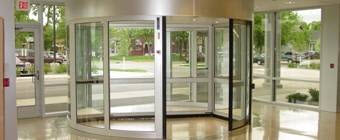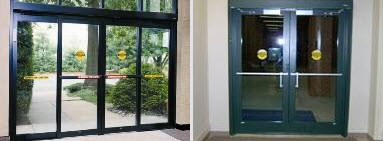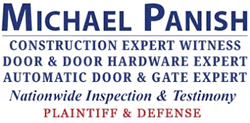articles
The Ins and Outs of Automatic Door Operation
As originally published by The Advocate Magazine, 2007.
By: Michael Panish
Tel: 888-902-4272
Email Mr. Panish
View Profile on Experts.com.
A basic primer in how they work, what to look for, and how to analyze defects vs. deferred maintenance. Expert door contractor, Michael Panish, takes you through the basics for your case. A basic primer about Automatic Door functions.

One of the most frequent calls I receive from attorneys is about injuries sustained from an automatic door malfunction. The call usually begins with a scenario much like, "My client, who is almost eighty years old, was in a hotel lobby, and as she was walking through the doorway to the parking lot, the sliding doors slammed shut on her, causing her to break her hip." Or, upon entering a revolving door, the door suddenly sped up, and actually trapped a young child between the door panel and the fixed portion of the doorway crushing the boy's arm and shoulder." " What can you tell me about the functions of the doors and why could this have happened? Do you think my client was careless? Was something wrong with the design of the door? How could this have been prevented? And, was this a maintenance issue? Who do you think is at fault for the defect in the operation of the door?"
In most cases the modern automatic door system, whether it be revolving, swinging or bi-pass/sliding type is designed with safety in mind. Multiple redundant safe guards have been incorporated into the design to assure the safe and secure usage of these products. The manufacturers' designs rely on multiple sources of sensory input to their products to assure safe and dependable operation. These door units are failure tested, for hundreds of thousands of cycles of usage, and are not generally put into public venues until they perform satisfactorily and dependably. They must meet the safety standards established by the American National Standards Institute (ANSI) guidelines.
SO, HOW DO THEY WORK?
Beginning with the most basic system... SWINGING DOORS (they either open inward or outward on fixed hinges) and BYPASS DOORS (the doors slide past each other, whether in a single or double pair) contain the most failure resistant safeguard, the ELECTRIC EYE BEAM. This sensor is used to assure that any object in the pathway of the closeable section of the door is protected against the door closing. In other words, picture a flashlight beam shining unbroken across a room onto a reflecting mirror or bicycle reflector. The door motor control would be sent a signal that all is clear, and then, the door would be activated to close safely, without hitting anything. However, if the beam is suddenly interrupted, a signal is immediately sent to the device to halt its closing action. In addition, automatic door systems usually incorporate an INFRARED CURTAIN SENSOR type of device (motion sensor or presence sensor). While optically undetectable, this type of sensor operates much like a shower head, spraying a fan of water. The sensor is usually positioned on both sides of a doorway. An infrared curtain beam rains down upon a position in front of the doorway to either trigger opening, or initiate the closing operation when the area protected by it is found to be occupied or clear of obstructions. On older systems, you may also encounter a PRESSURE SENSITIVE RUBBER MAT that contains sensors. When these mats are compressed, either by foot traffic, or a cart, such as in the case of a supermarket entrance, these devices send a signal to the motor controlling the door to initiate closing or opening, as needed.

The sensors that are built into these door systems all function interactively when working properly. They communicate via a microprocessor in the motor control unit to activate various door commands. In addition, built into these control boards are time delayed circuits that hold the doors in either an open or closed mode until the sensors are cleared or the doorway has been vacated. The harmonious interaction of these various sensing devices is critical, and if in proper working order, may in fact disable a malfunctioning doorway, assuring the protection of the passage of the pedestrian. When these sensor devices are either deactivated, tampered with, or malfunctioning due to lack of appropriate regular maintenance, these devices can become potentially deadly.
The motive systems (control motors and conveyance methods) of the door devices vary from manufacturer to manufacturer, some being more stable and reliable than others. Some products may employ plastic gears and parts that are less durable than others, sometimes made to be sacrificial in design to insure the safe operation of the automatic door unit or to disable a malfunctioning door device. In the more expensive and durable products, the products manufactured with chain driven or steel gear design usually rely upon a more sophisticated electronic control board to assure the safe or disabling functions of the doorway actions.
In addition to the sensor controls, many doorways also have a manual door operating switch. You may have seen these marked with a handicap symbol, or more simply "PUSH." These switches work in conjunction with the sensors to open the doorway, activating the motor control when the sensors verify that the area is clear.
The most sophisticated and complex automatic door system is the REVOLVING type. These types of doors are commonly found in airports, hotels and any area attempting a noise or thermal lock. The complexity and sophistication of these door systems require that there are an even greater number of safety sensors and motor controls. In addition to the types of devices mentioned previously, these revolving doors feature crush sensors located on door leading edges, or fixed panels, proximity beams to determine the speed of the rotation of the doorway, more beams to deactivate the door (if for some reason an object or person is attempting to enter the doorway at an inappropriate time), and an emergency stop device to halt the rotation of the doorway immediately without delay. There are usually manual door operating switches that can be used to slow the door rotation down, such as in the case of wheel chair use, and monitoring devices to show the condition of the door operation to the maintenance staff. These rotating doors frequently have memory devices that record function faults for future retrieval by service personnel.
With all of these safety devices in place on these doors, why do injuries occur? Poor design? Poor supervision? Lack of maintenance? Cost? Many of these factors play a part in causing injury. Poor design is usually not the primary reason for the injury. Having been called upon to examine thousands of doors during the past 25 years, and performing both installation and maintenance on all sorts of door products, the vast majority of the time a problem arises with any automatic or manual system, the owner of the property is not following the recommended guidelines of the manufacturer in one way or another. The most basic automatic door requires a daily safety check. Warning labels on the doorway systems are often forgotten or unheeded by managers who should take the inspection, care, and maintenance of these doors more seriously.
When an installation of an automatic door is completed, there should be a formal field demonstration of the product by the installer or manufacturer, as well as an extensive service and MAINTENANCE MANUAL given to the owner or management team of the building. Management should assure that training of their staff is adequate to understand the responsibilities of properly maintaining these door products. Manuals with detailed instructions that identify the responsibilities of the owner / user to guarantee the safe operation of the automatic door system are normally provided by the installation team. These manuals indicate the expected intervals of recommended service to the door system, daily safety checks, normal operation, special features as well as a suggested recommendation of keeping a service contract with the installer to do normal periodic maintenance and adjustments. New installations are one thing, transference of occupancy or building ownership often leads to problems with safety and service of these doors.
In some areas of maintenance, something AS SIMPLE AS WIPING AND CLEANING THE ELECTRONIC EYE LENSES is required for safe operation. This may need to be performed on a daily basis depending on the dirt and debris in the area and weather conditions. Other more complex diagnostics are not possible by the end users, and require regular attention from an installation professional. In most cases the basic maintenance of these door systems are something that should be addressed and attended to on a daily basis. I have been told by several manufacturers of automatic door systems that their products should be checked, tested and evaluated on a daily basis. These pieces of machinery are complicated and should be treated with the same type of care as if you were inspecting a theme park roller coaster ride. They simply must be looked at every day by trained personnel. Training can be obtained in the form of online information, video programs, and in house training by accredited or certified technicians.
As an attorney, the trail of responsibility of an injury is yours to explore. In pursuing the responsible parties, use the path from current owner to original equipment manufacturer. Many times, it has been the fault of the maintenance staff (directly linked to the owner of the property). Normal course and inclusion of a product manufacturer is where many attorneys choose to place the blame. However, I have found in many cases that the actual blame is on the part of the owner of the property who chooses improperly trained maintenance staff or uneducated personnel. They have chosen to ignore the requirements of the manufacturer as far as service and maintenance, and have opted to attempt to keep their costs down by not employing factory trained service technicians when called for. This has occurred in government owned facilities such as airports and court buildings, and has also been the case in supermarkets, restaurants, and commercial businesses. The decision to ignore the service requirements of the door manufacturer is often purely economic and is usually not in the operating scope of responsibility within many chain stores and commercial venues. They don't consider the operation of these doors to be as important as how they stock their shelves.
Michael Panish is an expert witness, forensic analyst, and consultant in the field of construction. He is licensed in the State of California as a General Building Contractor, Electrical Contractor, Door, Lock & Security Equipment Contractor, Cabinet & Millwork Contractor, and Painting Contractor. Michael has over 30 years hands-on experience in the construction industry. He has offices in California and New England and is available for nationwide consultation, forensic analysis, and testimony. Michael has consulted and testified in many injury cases pertaining to door related issues as well as most aspects of construction defects, product liability, and poor workmanship. Michael Panish can be reached at (818) 429-1963 (Ask for Sharon).
©Copyright - All Rights Reserved
DO NOT REPRODUCE WITHOUT WRITTEN PERMISSION BY AUTHOR.


